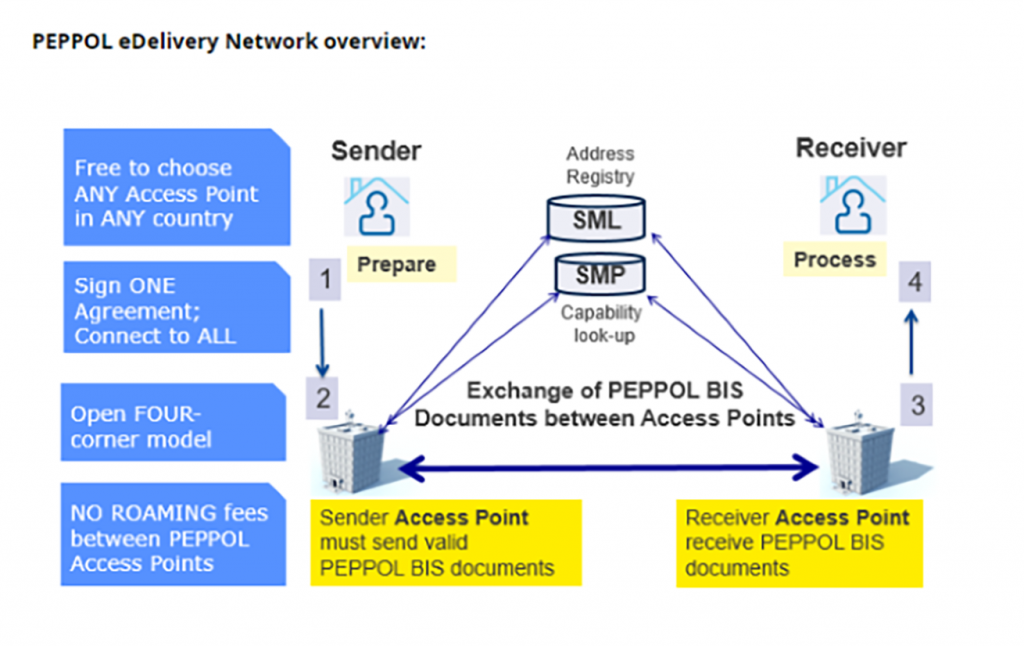About Peppol’s process models in general
Peppol process models (BIS=Business Interoperability Specification) are based on the decisions made by CEN (European Committee for Standardization) working groups Standard messages based on the UBL 2.1 and UBL 2.2 message specifications are used as the data model in the Peppol processes, and the Peppol messages are a subset of the data model of the corresponding UBL messages. Peppol has also specified business and other rules related to the messages and processes. To validate these rules, Schematron validation specifications have been prepared for the messages.
Peppol divides the processes into two main sets (pre-award and post-award specifications). Pre-award specifications are applied to information exchanges taking place during the pre-contract tendering stage, whereas post-award specifications are applied to the sharing of information during the order-to-invoice stage. The same UBL-based messages are often used in different business processes and partially in both pre-award and post-award phases.
The process specification contained in the messages indicates the context in which the message is used in each individual situation. For example, the UBL message product catalogue is used in both pre-award and post-award phases. In the pre-award phase, the product catalogue is used to present the product information contained in the tender so that the customer can compare the tenders. The product catalogue used in the post-award phase is usually more comprehensive than the one used in the pre-award phase, and the information is used to facilitate ordering.
A uniform data model is a prerequisite for the consistent use of multiple datasets and code sets in different messages and processes. Examples of such applications include message routing addresses, information of the participants, and measurement units. Considerable progress has been achieved in the standardisation of these datasets as a result of the e-invoice standardisation carried out in the EU.
Process models
The purpose of the process models is to describe concrete use cases. Not all processes are obligatory, or even necessary for all actors. There may also be sector-specific and national differences in the application of the processes, even though the basic processes themselves are uniform. For example, procurement by Finnish government agencies is regulated and steered by legislation on public contracts and the State Budget Decree. This means that there are a number of special requirements concerning the order process that do not apply to all organisations.
Pre-award process models and the messages used in them
| Prosessi |
Aliprosessit |
Käytettävä UBL-sanoma |
| ”Procurement procedure subscription” 1.0 |
Subscribe to Procedure 1.0 |
Expression Of Interest Request |
|
Subscribe to Procedure Confirmation 1.0 |
Expression Of Interest Response |
| ”Procurement document access” 1.0 |
Tender Status Inquiry 1.0 |
Tender Status Request |
|
Call for Tenders 1.0 |
Call for Tenders |
| ”Tender Submission” 1.0 |
Tender 1.0 |
Tender |
|
Tender Reception Notification 1.0 |
Tender Receipt |
| ”Call for Tenders Questions and Answers” 1.0 |
Tendering Questions 1.0 |
Tendering Questions |
|
Tendering Answers 1.0 |
Tendering Answers |
| ”Tender Clarification” 1.0 |
Tender Clarification Request 1.0 |
Tender Clarification Request |
|
Tender Clarification 1.0 |
Tender Clarification |
Peppol’s pre-award content also includes data models, XML schemas and validation programs developed by the EU’s DG GROW, such as the ESPD (European Single Procurement Document) in the area of public procurement. ESPD comprises the transmission of two documents: ESPDRequest and ESPDResponse. ESPDRequest contains preliminary requirements for the tenderer in public contracts, and ESPDResponse contains the tenderer’s response to these requirements.
Business interoperability specifications
A range of different business interoperability specifications have been drawn up for the process ‘from order to invoicing’.
| Business interoperability specification |
Messages used in the process |
| Order only 3.3 |
Order |
| Ordering 3.3) |
Order, Order Response |
| Catalogue with Response 3.1 |
Catalogue, Catalogue Response |
| Catalogue without Response 3.1 |
Catalogue |
| Despatch Advice 3.1 |
Despatch Advice |
| Punch Out 3.1 |
Punch Out |
| Order Agreement 3.0 |
Order Agreement |
| Message Level Response 3.0 |
Message level response |
| Invoice Response 3.2 |
Invoice Response |
| Billing 3.0 (Europe) |
Invoice, Credit Note |
| Advanced Ordering 3.0 |
Order, Order Response Advanced, Order Change, Order Cancellation |
Table: Different organisations have different information exchange needs. Organisations can choose which business interoperability specifications and procurement messages are supported in their own information systems.
Post-award process models and the messages used in themPeppol post-award process models and messages also include an invoice message, which is not discussed in more detail in this context. The Peppol invoice message is based on a similar UBL message and it is content-compatible with the EU e-invoice standard (which has been standardised by CEN).
The general Message Level Response 3.0 notification and the Invoice Response 3.0 notification have also been implemented in the post-award specifications. Both notification messages are based on the UBL ApplicationResponse 2.1 message.
Observations on post-award models
Peppol has implemented a subset of the UBL expression power in its processes. For example, OrderCancel and OrderChange are not included in the models. Similarly, Peppol models do not include ReceiptAdvice. In some countries, such as Norway, non-Peppol messages and processes are included in the national EHF implementation. Peppol Authorities can also suggest necessary extensions to process and data models.
It can be said that Peppol has implemented the basic processes and data models of the procurement process. The specifications are a subset of the full expression power of the UBL data models but are likely to provide an adequate general basis that meets most of the organisations’ needs. All specifications are subject to technical and business rules and their validation tools. It facilitates the quality assurance of the transmitted data, which is necessary in automated processing.
The general business and technical validation rules included in the models are an undeniable advantage of Peppol process and data models compared to the traditional EDIFACT integrations. Common validation rules harmonise the application process and facilitate the implementation of well-functioning services.
Overall, Peppol brings the same benefits as standardisation in general. Standardisation enhances understanding of the concepts and terms of the parties involved and provides a solid basis for system and software development.

